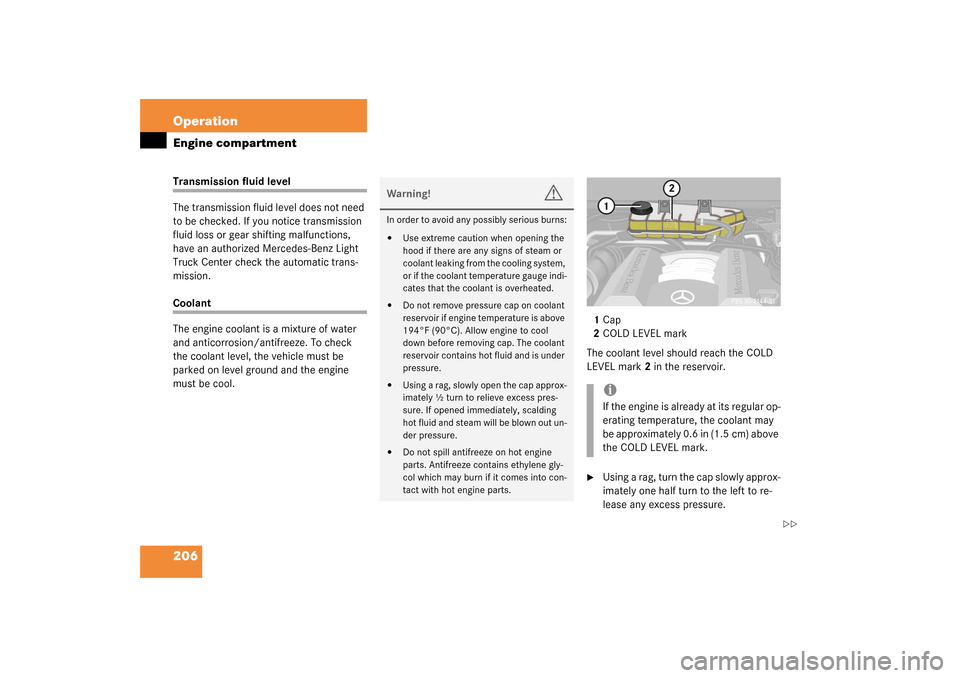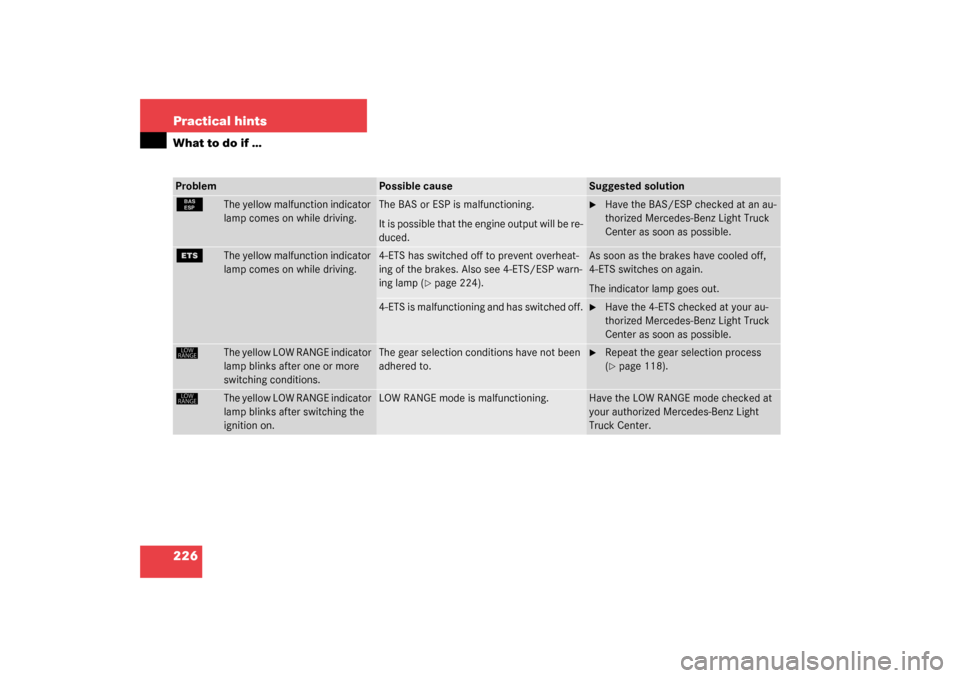Page 206 of 321

206 OperationEngine compartmentTransmission fluid level
The transmission fluid level does not need
to be checked. If you notice transmission
fluid loss or gear shifting malfunctions,
have an authorized Mercedes-Benz Light
Truck Center check the automatic trans-
mission.Coolant
The engine coolant is a mixture of water
and anticorrosion/antifreeze. To check
the coolant level, the vehicle must be
parked on level ground and the engine
must be cool. 1Cap
2COLD LEVEL mark
The coolant level should reach the COLD
LEVEL mark2 in the reservoir.
�
Using a rag, turn the cap slowly approx-
imately one half turn to the left to re-
lease any excess pressure.
Warning!
G
In order to avoid any possibly serious burns:�
Use extreme caution when opening the
hood if there are any signs of steam or
coolant leaking from the cooling system,
or if the coolant temperature gauge indi-
cates that the coolant is overheated.
�
Do not remove pressure cap on coolant
reservoir if engine temperature is above
194°F (90°C). Allow engine to cool
down before removing cap. The coolant
reservoir contains hot fluid and is under
pressure.
�
Using a rag, slowly open the cap approx-
imately ½ turn to relieve excess pres-
sure. If opened immediately, scalding
hot fluid and steam will be blown out un-
der pressure.
�
Do not spill antifreeze on hot engine
parts. Antifreeze contains ethylene gly-
col which may burn if it comes into con-
tact with hot engine parts.
iIf the engine is already at its regular op-
erating temperature, the coolant may
be approximately 0.6 in (1.5 cm) above
the COLD LEVEL mark.
��
Page 226 of 321

226 Practical hintsWhat to do if …¿
The yellow malfunction indicator
lamp comes on while driving.
The BAS or ESP is malfunctioning.
It is possible that the engine output will be re-
duced.
�
Have the BAS/ESP checked at an au-
thorized Mercedes-Benz Light Truck
Center as soon as possible.
{
The yellow malfunction indicator
lamp comes on while driving.
4-ETS has switched off to prevent overheat-
ing of the brakes. Also see 4-ETS/ESP warn-
ing lamp (
�page 224).
As soon as the brakes have cooled off,
4-ETS switches on again.
The indicator lamp goes out.
4-ETS is malfunctioning and has switched off.
�
Have the 4-ETS checked at your au-
thorized Mercedes-Benz Light Truck
Center as soon as possible.
ê
The yellow LOW RANGE indicator
lamp blinks after one or more
switching conditions.
The gear selection conditions have not been
adhered to.
�
Repeat the gear selection process
(�page 118).
ê
The yellow LOW RANGE indicator
lamp blinks after switching the
ignition on.
LOW RANGE mode is malfunctioning.
Have the LOW RANGE mode checked at
your authorized Mercedes-Benz Light
Truck Center.
Problem
Possible cause
Suggested solution
Page 230 of 321

230 Practical hintsWhat to do if …Problem
Possible cause
Suggested solution
/
The yellow coolant warning lamp
lights up when the engine is run-
ning.
The coolant is to hot.
The coolant level is too low.
�
Stop as soon as possible and allow
the engine and coolant to cool down.
�
Check the coolant level and add
coolant if necessary (
�page 206).
If the warning lamp lights up frequently, there
is a leak in the cooling system.
�
Have the cooling system checked by
an authorized Mercedes-Benz Light
Truck Center.
The coolant temperature gauge is above
248 °F (120 °C).
The coolant level is too low.
�
Stop as soon as possible and allow
the engine and coolant to cool down.
�
Add coolant to prevent engine from
overheating (
�page 206).
If the coolant level is correct, the electrical
radiator fan may be broken.
�
If the coolant temperature is below
the red zone, drive on to the nearest
authorized Mercedes-Benz Light
Truck Center.
Avoid high engine loads (e.g. driving
uphill) and stop-and-go driving.
Page 231 of 321
231 Practical hints
What to do if …
Warning!
G
Driving when your engine is badly overheat-
ed can cause some fluids which may have
leaked into the engine compartment to
catch fire. You could be seriously burned.
Steam from an overheated engine can cause
serious burns and can occur just by opening
the engine hood. Stay away from the engine
if you see or hear steam coming from it.
Turn off the engine, get out of the vehicle
and do not stand near the vehicle until it
cools down.Warning!
G
Do not spill antifreeze on hot engine parts.
Antifreeze contains ethylene glycol which
may burn if it comes into contact with hot
engine parts. You can be seriously burned.
!Do not ignore the coolant warning
lamps. Extended driving with the sym-
bol displayed may cause serious engine
damage not covered by the
Mercedes-Benz Limited Warranty.
Do not drive without sufficient amount
of coolant. The engine will overheat,
causing major engine damage.
Page 259 of 321

259 Practical hints
Flat tire
Inflating the spare wheel with
collapsible tire�
Take the electric air pump out of the
rear cargo compartment (
�page 238).
1Union nut
2Electrical plug
3Air hose with pressure gauge
4Vent screw
�
Open flap on air pump.
�
Pull out electrical plug2 and air hose
with the pressure gauge3.
�
Close the vent screw4.
�
Remove the valve cap from the spare
wheel tire valve.
�
Screw the union nut1 with air hose3
on to the tire valve.
�
Insert electrical plug 2 into the electri-
cal outlet in the front passenger foot-
well or rear cargo compartment
(�page 158).
�
Start the engine.
�
Switch on the air pump.
�
Operate air pump until the pressure
gauge displays 61 psi (4.2 bar)
This takes about eight minutes for the
collapsible tire. The air hose 3 and the
union nut 1 can become hot during in-
flation. Please exercise appropriate
caution.
�
Switch off the air pump.
�
Turn off the engine.
�
If the tire pressure is above 61 psi
(4.2 bar), release excess tire pressure
using the vent screw4.
Warning!
G
Observe instructions on air pump label.
!Do not operate the electric air pump
longer than eight minutes without in-
terruption. Otherwise it may overheat.
You may operate the air pump again af-
ter it has cooled off.